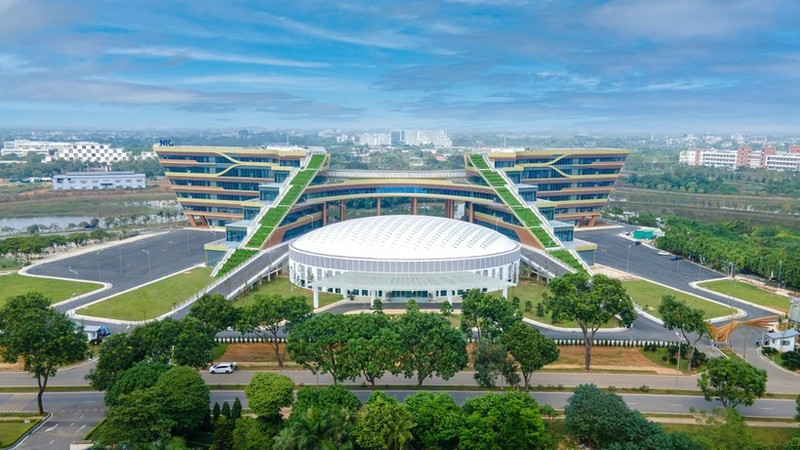A new driving force for the capital region
The Ha Noi Capital Region, as the political, economic, and cultural centre of the country, is facing a historic opportunity to make a breakthrough. Alongside new mechanisms, policies, and synchronised infrastructure, the policy of merging administrative units not only expands development space but also creates strong momentum for socio-economic growth.

A launchpad for growth
According to Resolution 60/NQ-TW dated April 12, 2025, the administrative unit mergers will streamline the Capital Region from ten to seven provinces and cities: Ha Noi, Hung Yen (merged with Thai Binh), Ninh Binh (merged with Ha Nam and Nam Dinh), Phu Tho (merged with Vinh Phuc and Hoa Binh), Bac Ninh (merged with Bac Giang), Thai Nguyen (merged with Bac Kan), and Quang Ninh.
Dr Can Van Luc believes that the administrative merger will create new growth poles, helping the Capital Region’s economy account for around 25-28% of the national total by 2030. The restructuring not only streamlines the administrative apparatus but also synchronises planning, forming strategic economic corridors around Ha Noi.
Dr Tran Dinh Thien also emphasised that the 2024 Capital Law lays the foundation for Ha Noi to transform from a political-cultural hub into an economic driver of the Red River Delta. The core urban model is gradually shifting towards a chain urban model, extending to Bac Ninh, Vinh Phuc, Hung Yen, with the goal of becoming centrally governed cities.
According to Dr Nguyen Van Dinh, Vice Chairman of the Real Estate Brokers Association, provinces such as Bac Ninh, Hung Yen, and the city of Hai Phong are all playing the role of “production-logistics belts” for the capital, promoting high-tech industry and satellite urban areas. For example, Hung Yen is attracting major projects from leading real estate firms, while Hai Phong has become a logistics hub with an international deep-water port.
Dr Nguyen Quang Tuyen recommended that the “Capital Region” should be clearly defined to enable effective management and planning. Regional linkage is not merely an administrative arrangement but an opportunity to develop multi-dimensional space, from urban centres to coastal and mountainous areas. Transport and digital infrastructure are considered the backbone for enhancing regional connectivity.
Currently, the Capital Region features seven ring roads, including five main ones (Ring Roads 1, 2, 3, 4, and 5) and two auxiliary routes (Ring Roads 2.5 and 3.5).
Among localities, Hung Yen is emerging as a new industrial hub focusing on high-tech and agricultural processing. Meanwhile, Hai Phong has long been the leading seaport and logistics centre in the north, with an international deep-water port system that facilitates trade with global markets. Hai Duong is also promoting supporting industries and logistics services, contributing to a synchronised and efficient regional economy.
This connectivity drives the industrial, commercial, and real estate sectors. Ha Noi maintains its central spreading role, supporting industrial provinces such as Bac Ninh, Bac Giang, Thai Nguyen, and Vinh Phuc to accelerate thanks to regional infrastructure. A multi-polar urban model is taking shape, creating new growth poles for the north.
Dr Nguyen Dinh Tho, Deputy Director of the Institute of Strategy and Policy on Agriculture and Environment, stressed that coastal connectivity through Hai Phong and Quang Ninh will enable the Capital Region to become a centre for logistics and international trade.
Finally, infrastructure connectivity involves not only transport but also the digital space. The Capital Region needs to expand into the digital realm, underground space, and marine space to meet the demands of multi-dimensional development. Smart urban projects in Dong Anh and Gia Lam are examples of a new, modern development direction that appeals to international investors.
Institutional reform and public asset management
The Capital Region is standing at a new turning point to become a civilised and modern urban region, with institutional reform and public asset management being fundamental to harnessing the power of regional connectivity.
Dr Nguyen Van Khoi, Chairman of the Viet Nam Real Estate Association, affirmed: “The legal system on land, housing, and urban planning is being comprehensively revised, creating a transparent legal foundation for socio-economic development.” Alongside the high hopes for a reinvigorated Capital Region, there remain issues that need proper attention now and in the future.
Regarding the use of public assets, Dr Nguyen Quang Tuyen remarked: “There is no clear legal mechanism to repurpose surplus public assets after the mergers, which could lead to a waste of resources.”
He proposed that the National Assembly issue a transitional resolution to delineate land management responsibilities between provincial and communal levels, and to allow private companies to participate in developing public land, such as converting it into urban areas or commercial centres. This would not only unlock resources but also attract private investment, particularly in social housing and industrial park projects.
The sustainable development of the Capital Region requires joint efforts from the state, businesses, and the public. With a target GDP growth rate of 8% in 2025 and double digits from 2026 onwards, the Capital Region has the opportunity to become a regional centre of economy, technology and culture. The new Capital Region, with favourable conditions, is not just a story of Ha Noi and the provinces and cities within it, but a vital piece in realising the country’s broader aspirations.
Turning the Capital Region into a symbol of prosperity and sustainable development will require decisive action, strategic vision, and concerted coordination; thereby creating synergy, amplifying potential, and realising the promise of each locality and the entire region.








